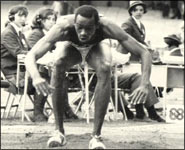|
Game Over:
Brain Injury and Sports
Once part of every athlete’s
life,
brain injury is now changing
the rules of the game
By Marc Lallanilla
January 2011 — Mike Borich was a handsome and talented young athlete with a promising
career ahead of him. A wide receiver at Western Illinois University known for his spectacular catches, Borich never played
football professionally. Instead, he went on to an award-winning coaching career with the Chicago Bears, Brigham Young University
and other Division 1 college teams.
But by 2003, Borich’s career seemed to be slowing down. He resigned from a coaching
position at University of Arizona after just three months, citing personal reasons. The married father of three children,
Borich’s life was becoming a swirl of alcohol and drug abuse. Violent mood swings and aggressive behavior were complicated
by bouts of disorientation, depression, and forgetfulness—he sometimes missed team buses, or checked into the wrong
hotel. In 2009, at the age of 42, Borich was dead of an overdose of alcohol, cocaine and OxyContin.

While Borich’s friends and relatives remembered a dedicated coach and family man, his
father Joe also remembered the concussions his son had suffered—nine or 10, though nobody really counted at the time,
because concussions were just considered part of the game. After his son’s death, Joe Borich donated his son’s
brain to the Center for the Study of Traumatic Encephalopathy at Boston University. Researchers there found that the brain
showed an advanced case of chronic traumatic encephalopathy, or CTE.
Once known as dementia pugilistica for the many boxers who were “punch drunk,”
CTE has received greater attention recently as more and more athletes—professional jocks as well as recreational players
and weekend warriors—have been found to have the disorder. In addition to boxers and football players, it’s been
discovered in other people who suffer repeated head trauma: hockey, soccer, and rugby players, wrestlers, equestrian athletes,
domestic abuse victims—even a circus clown who was subject to repeated “dwarf-tossing” contests.
Building a Better Jock
Can Science Create a Stronger, Faster Olympian?
Some Say Yes; Others Disagree
By MARC LALLANILLA

Aug. 13, 2004
— In the Mexico City Olympics of 1968, Bob Beamon stunned the athletic world
when he shattered the record for the men's long jump. Leaping over 29 feet, he beat the former record by almost 2 feet —
so far that the officials' measuring rail didn't even extend that distance.
What unlocks these record-setting performances? For many coaches and
athletes, the answer seems to be science, in the form of nutrition, physiology and materials technology.
But is the reliance on new scientific innovations stealing the soul
of athletic competition?

|
| Bob Beamon lept into the record books with his 1968 Olympic long jump. (AP Photo) |
What
athletes eat and drink — the super-foods precisely engineered to address their nutrient needs — is one of the
ways that science lends a helping hand.
"We have foods now that are specifically designed for athletes," says
Ron Pfeiffer, professor of kinesiology at Boise State University in Idaho and co-director of its Center for Orthopedic and
Biomechanics Research.
"Elite athletes aren't the kinds of people you'll see walking down
the street next to you," Pfeiffer adds. "They have different nutritional needs. Their diets are carefully monitored for things
like muscle glycogen and liver glycogen levels."
Some companies have excelled at devising sports drinks and other products
that address athletes' fluid-replacement and carbohydrate needs. But are these super-foods creating super-athletes?
Pfeiffer, like most others in sports science, doesn't think so. "There's
no real magic to it," he says, though he doesn't think anyone is likely to return to the diets of a generation ago.
"I didn't know a protein from a hockey puck when I went to the Olympic
trials for speed skating in 1968 and 1972," Pfeiffer says.
For the full story, go to ABC News
What's the Buzz on Energy Drinks for Kids?
Some Critics Call Caffeine Drinks for Children Risky
By MARC LALLANILLA

Sept. 26, 2005 — There's nothing new in marketing products
to children, even products intended for adults. But doctors are concerned that a new sports drink containing caffeine and
other substances, marketed to children as young as 4 years old, may have gone too far.
Spark, a product aimed at adults and teens manufactured by Advocare of Carrollton,
Texas, contains 120 milligrams of caffeine — roughly the same amount as a cup of coffee — as well as 200 mg of
taurine and 50 mg of gamma-aminobutyric acid, a compound with stimulant properties.
These ingredients are usually found in energy drinks and sports beverages intended
for elite athletes.

|
| (PhotoDisc) |
KickStart Spark, a related product specifically marketed for children 4 years and older, contains even more gamma-aminobutyric
acid (100 mg), 200 mg of taurine and 60 mg of caffeine.
"This is shameful marketing," said Madelyn H. Fernstrom, associate professor and director of the University of Pittsburgh
Medical Center Weight Management Center. "Under the guise of 'good health,' this is a promotion of caffeine consumption, which
will likely have a biological effect on most children who consume it, since their intake is low."
For the full story, go to ABC News
|

